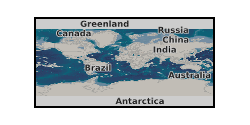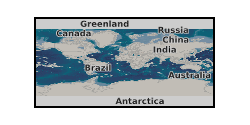service
Type of resources
Available actions
Keywords
Contact for the resource
Provided by
Years
Formats
Update frequencies
Service types
-

This INSPIRE network service provides an Atom feed of predefined datasets that are available for download.
-
This is a web map service (WMS) for the 10-metre Land Cover Map 2023. The map presents the and surface classified into 21 UKCEH land cover classes, based upon Biodiversity Action Plan broad habitats.
-

The joint PHE-BGS digital Indicative Atlas of Radon in Great Britain presents an overview of the results of detailed mapping of radon potential, defined as the estimated percentage of homes in an area above the radon Action Level. The Indicative Atlas of Radon in Great Britain presents a simplified version of the Radon Potential Dataset for Great Britain with each 1-km grid square being classed according to the highest radon potential found within it, so is indicative rather than definitive. The joint PHE-BGS digital Radon Potential Dataset for Great Britain provides the current definitive map of radon Affected Areas in Great Britain.
-

BGS Data Catalogue discovery service API. Provides human and computer accessible interface to BGS metadata records
-

Note: This dataset is designed for the 1:50000 scale but can be viewed in this WMS between 1:100000 and 1:25000 (Only). The 1:50 000 DiGMapGB data covering the whole of the United Kingdom is available in this OGC WMS service for your personal, non-commercial use only. Separate bedrock geology, superficial deposits, artificial ground, mass movement deposits and geological linear features layers are available in this service. For information about more of the British Geological Survey's maps that are available digitally please visit https://www.bgs.ac.uk/geological-data/.
-
This web map service shows estimates of stock (length) of linear features across Great Britain in 2007, 1998, 1990 and 1984. The data are national estimates generated by analysing the sample data from 1km squares surveyed for the Countryside Survey in each of those years, then scaling up to a national level. The data are presented as the estimated mean length of linear features (hedgerows, walls, fences, banks, grass strips and tree lines) per 1km square within 45 different Land Class types based on the ITE Land Classification. The Countryside Survey is a unique study or 'audit' of the natural resources of the UK's countryside, carried out by the Centre for Ecology & Hydrology. The sample sites are chosen from a stratified random sample, based on a 15 by 15 km grid of GB. Surveys have been carried out in 1978, 1984, 1990, 1998 and 2007 with repeated visits to the majority of squares. The countryside is sampled and surveyed using rigorous scientific methods, allowing us to compare new results with those from previous surveys. In this way we can detect the gradual and subtle changes that occur in the UK's countryside over time. In addition to linear features, habitat areas, species plot, soil plot, freshwater habitat and satellite map data are also produced by Countryside Survey.
-

This service is the BGS contribution to the OneGeology project, providing UK onshore geological data at 1:625 000 scale and UK continental shelf seabed sediment data at 1:1 million scale. This map data is collected as part of an ongoing BGS project: Digital Geological Map of Great Britain (DiGMapGB). MapServer software is used to provide these OGC WMS and WFS services.
-
This web map service (WMS) depicts estimates of mean values of soil bacteria, invertebrates, carbon, nutrients and pH within selected habitats and parent material characteristics across GB . Estimates were made using CS data using a mixed model approach. The estimated means of habitat/parent material combinations using 2007 data are modelled on dominant habitat and parent material characteristics derived from the Land Cover Map 2007 and Parent Material Model 2009, respectively. Bacteria data is representative of 0 - 15 cm soil depth and includes bacterial community structure as assessed by ordination scores. Invertebrate data is representative of 0 - 8 cm soil depth and includes Total catch, Mite:Springtail ratio, Number of broad taxa and Shannon diversity. Gravimetric moisture content (%) data is representative of 0 - 15 cm soil depth Carbon data is representative of 0-15 cm soil depth and includes Loss-on-ignition (%), Carbon concentration (g kg-1) and Carbon density (t ha-1). Loss-on-ignition was determined by combustion of 10g dry soil at 375 deg C for 16 hours; carbon concentration was estimated by multiplying LOI by a factor of 0.55, and carbon density was estimated by combining carbon concentration with bulk density estimates. Nutrient data is representative of 0 - 15 cm soil depth and includes total nitrogen (N) concentration (%), C:N ratio and Olsen-Phosphorus (mg/kg). pH and bulk density (g cm-3) data is representative of 0 - 15 cm soil depth. Topsoil pH was measured using 10g of field moist soil with 25ml de-ionised water giving a ratio of soil to water of 1:2.5 by weight; bulk density was estimated by making detailed weight measurements throughout the soil processing procedure. Areas, such as urban and littoral rock, are not sampled by CS and therefore have no associated data. Also, in some circumstances sample sizes for particular habitat/parent material combinations were insufficient to estimate mean values.
-
This web map service (WMS) shows a 1km resolution raster version of the Land Cover Map 2007 for Great Britain. Each 1km pixel represents the dominant target class across the 1km area. The target classes broadly represent Broad Habitats (see below). The dataset is part of a series of data products produced by the Centre for Ecology & Hydrology known as LCM2007. LCM2007 is a parcel-based thematic classification of satellite image data covering the entire United Kingdom. The map updates and upgrades the Land Cover Map of Great Britain (LCMGB) 1990 and LCM2000. Like the earlier 1990 and 2000 products, LCM2007 is derived from a computer classification of satellite scenes obtained mainly from Landsat, IRS and SPOT sensors and also incorporates information derived from other ancillary datasets. LCM2007 was classified using a nomenclature corresponding to the Joint Nature Conservation Committee (JNCC) Broad Habitats, which encompasses the entire range of UK habitats. In addition, it recorded further detail where possible. The series of LCM2007 products includes vector and raster formats, with a number of different versions containing varying levels of detail and at different spatial resolutions.
-
This is a web map service (WMS) for the 10-metre Land Cover Map 2021. The map presents the and surface classified into 21 UKCEH land cover classes, based upon Biodiversity Action Plan broad habitats.
 NERC Data Catalogue Service
NERC Data Catalogue Service